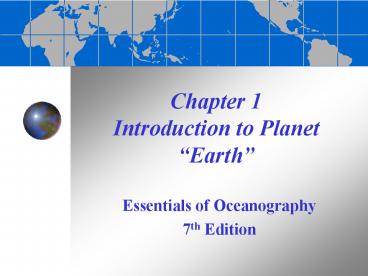Chapter 1 Introduction to Planet Earth - PowerPoint PPT Presentation
1 / 21
Title:
Chapter 1 Introduction to Planet Earth
Description:
Chapter 1 Introduction to Planet Earth Essentials of Oceanography 7th Edition * * Geography of the oceans Earth s oceans: Cover 70.8% of Earth s surface Are ... – PowerPoint PPT presentation
Number of Views:594
Avg rating:3.0/5.0
Title: Chapter 1 Introduction to Planet Earth
1
Chapter 1Introduction to Planet Earth
- Essentials of Oceanography
- 7th Edition
2
Geography of the oceans
- Earths oceans
- Cover 70.8 of Earths surface
- Are interconnected (world ocean)
- Have huge size and volume (as a reservoir,
contain 97 of Earths water)
3
The four principal oceans
- Pacific
- Atlantic
- Indian
- Arctic
- Plus
- Southern or Antarctic Ocean
Figure 1-2
4
Comparing oceans to the continents
Figure 1-3
5
Comparing depth of the oceans to elevation on land
Figure 1-4
6
Early exploration of the oceans
- Pacific navigators peopled many remote islands
Figure 1-6
7
Early exploration of the oceans
- Advancements of European navigators
- Phoenicians explored the Mediterranean Sea and
beyond - Pytheas developed method to determine latitude
- Eratosthenes calculated circumference of Earth
- Ptolemy produced map that shows known land
surrounded by largely unexplored oceans
8
Early exploration of the oceans
- The Vikings explored the North Atlantic and
established many colonies
Figure 1-7
9
Early exploration of the oceans
- During the Age of Discovery, Columbus and
Magellan make journeys of exploration
Figure 1-8
10
Early exploration of the oceans
- Voyaging for science began with English navigator
and explorer Captain James Cook - Mapped many unknown islands
- Determined outline of the Pacific Ocean
- Sampled ocean properties
- Modified shipboard diet to eliminate scurvy
- Used John Harrisons chronometer to determine
longitude
11
The scientific method
Figure 1-10
12
Origin of the Solar System and Earth
- Cloud of gas and space dust (nebula) began to
contract about 4.6 billion years ago
The Nebular Hypothesis
Figure 1-12
13
Origin of the Solar System and Earth
- Protoplanets were created from the nebula
- Protoearth was initially homogenous
- Larger in size than todays Earth
- Had lots of volcanic activity
- No continents or oceans
- No life
14
Density stratification
- Protoearth experiences density stratification
- Density how heavy something is for its size
- Density stratification causes high density
material to sink while low density material rises - High density material rock material and metals
- Low density material gases
15
Density stratification creates a layered Earth
Figure 1-13
16
Origin of the oceans
- As a result of density stratification, water for
the oceans is outgassed from inside Earth
Figure 1-14
17
Origin of the atmosphere
- Density stratification caused Earths early
atmosphere (water vapor and carbon dioxide) to be
outgassed from inside Earth - The initial atmosphere was rich in hydrogen and
helium - Earths present atmosphere is rich in nitrogen
and oxygen
18
Photosynthesis releases oxygen to the atmosphere
Figure 1-16
19
Origin of life on Earth
- Stanley Millers experiment simulating conditions
of an early Earth showed that life probably began
in the oceans
Figure 1-15
20
Major events in Earths development
Figure 1F
21
End of Chapter 1
- Essentials of Oceanography
- 7th Edition































